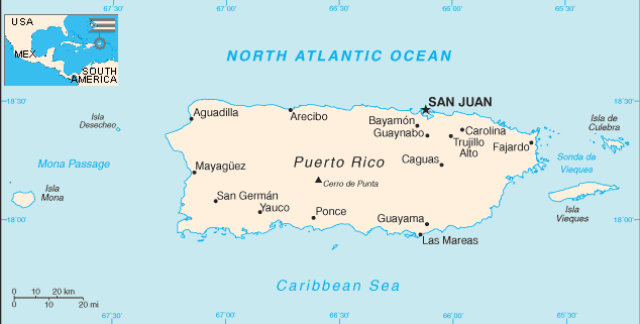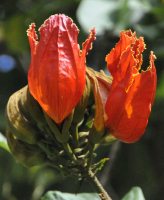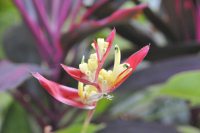Puerto Rico

|
Puerto
Rico
The history of the archipelago of Puerto Rico before the arrival in 1493 of Christopher Columbus is not well known. The first comprehensive book on the history of Puerto Rico was written by Fray Inigo Abbad y Lasierra in 1786, two hundred and ninety three years after the first Spaniards arrived on the island. The first settlers were the Ortoiroid people, an Archaic Period culture of Amerindian hunters and fishermen. An archaeological dig in the island of Vieques in 1990 found the remains of what is believed to be an Archaic man - named Puerto Ferro, dated to around 2000 BC. Between AD 120 and 400 the Igneri arrived, a tribe from the Orinoco region. Between the 4th and 10th centuries, the Arcaicos and Igneri co-existed (and perhaps clashed) on the island. Between the 7th and 11th centuries the Taino culture developed on the island and by approximately 1000 AD had become dominant.
Spanish colony Christopher Columbus arrived in Puerto Rico (during his second voyage) on
the 19th of November 1493, he named the island San Juan
Bautista, in honour of Saint John the Baptist. Later the island took the name of
Puerto Rico - Spanish for Rich Port. The capital was named San Juan. In 1508,
Spanish conquistador Juan Ponce de Leon became the island's first governor.
The
Spanish soon colonised the island. Tainos were forced into slavery and were
decimated by the harsh conditions of work and by diseases brought by the
Spaniards. In 1511, the Tainos revolted when their chief ordered his warriors to
drown the Spanish soldier Diego Salcedo to determine whether the Spaniards were
immortal. After drowning Salcedo, they kept watch over his body for three days
to confirm his death. The revolt was defeated
by Ponce de León's men and within a few decades much of the native population
had been decimated by disease, violence, and a high occurrence of suicide. By
1520, when Charles V issued a royal decree that collectively emancipated the
remaining Taino population, their presence had almost
vanished. African slaves were introduced to replace the Taino. Puerto Rico soon became an important stronghold and port for the Spanish Empire. Various forts and walls were built to protect the port of San Juan from European enemies. France, The Netherlands and England made several attempts to capture Puerto Rico but failed to wrest long-term occupancy. During the late 17th and early 18th centuries colonial emphasis was on the more prosperous mainland territories, leaving the island impoverished of settlers.
In 1809, in the midst of the Peninsular War, the Supreme Central Junta based in Cadiz recognized Puerto Rico as an overseas province of Spain with the right to send representatives to the recently convened Spanish Parliament. After the rapid gaining of independence by the South and Central American states in the first part of the century, Puerto Rico and Cuba became the only Spanish colonies found in the Americas. The Spanish Crown revived the Royal Decree of Graces of 1815. Free land was offered to those who wanted to populate the islands on the condition that they swear their loyalty to the Spanish Crown and allegiance to the Catholic Church. Toward the end of the 19th century, poverty and political estrangement with Spain led to a small but significant uprising in 1868. It began in the rural town of Lares. Leaders of this independence movement included Ramon Betances, considered the "father" of the independence movement. General elections were held in March and the autonomous government began to function on the 17th of July 1898.
United States colony On the 25th of July 1898, during the Spanish-American War, Puerto Rico was invaded by the US, landing at Guanica. As an outcome of the war, Spain ceded Puerto Rico, along with Cuba, the Philippines and Guam under the Treaty of Paris. Commonwealth, in 1947 the US granted Puerto Ricans the right to democratically elect their own governor. The Constitution of Puerto Rico was approved by a Constitutional Convention on the 6th of February 1952, ratified by the US Congress, approved by President Truman on the 3rd of July that year, and proclaimed by Gov. Munoz Marin on the 25th of July 1952, the anniversary of the arrival of US troops to the island. During the 1950's Puerto Rico experienced rapid industrialization, due in large part to "Operation Bootstrap", an offshoot of FDR's New Deal, which aimed to transform Puerto Rico's economy from agriculture-based to manufacturing-based. Presently, Puerto Rico has become a major tourist destination and is an important component of Puerto Rican economy supplying an approximate $1.8 billion. In 1999, an estimated 5 million tourists visited the island, most from the US. Nearly a third of these are cruise ship passengers. The island is the world's leading pharmaceutical manufacturing center. Playas des Americas, in the suburbs of San Juan is the largest shopping mall in the Caribbean with many top brand stores. There is every imaginable eatery with all the major US franchises represented. Yet it still struggles to define its political status.
We drove past the vast Baxter Plant, makers of generic drugs, curse of my pharmaceutical selling life, also next door was a huge Pfizer Plant
On
the 25th of October 2006, the Puerto Rico State Department conferred Puerto
Rican citizenship to Juan Mari Bras. The Supreme Court of Puerto Rico and the
Puerto Rican Secretary of Justice determined that Puerto Rican citizenship
exists and was recognized in the Constitution of Puerto Rico. Since the summer
of 2007, the Puerto Rico State Department has developed the protocol to provide
certificates of Puerto Rican citizenship to Puerto Ricans. Certificates of
Puerto Rican citizenship are issued to any persons born on the island as well as
to those born outside of the island that have at least one parent who was born
on the island. Any US citizen with at least one year of residence on the island
is also eligible for the official citizenship certificate. The certificate is
not a valid travel document. Government and politics Puerto Rico has a republican form of government, subject to US
jurisdiction and sovereignty. Its current powers are all delegated by the US
Congress and lack full protection under the US Constitution. Puerto Rico's head
of state is the US President. As Puerto Rico is not an independent country, it
hosts no embassies. It is host, however, to
consulates from forty one countries, mainly from the
Americas and Europe Political status Puerto Rico is an "unincorporated territory" of the US which means it belongs but is not part of the United States. Since 1917, people born in Puerto Rico are US Citizens. However, federal electoral law does not grant a vote to any citizen who does not live in, or qualify as an absentee resident in, one of the fifty states or the District of Columbia. Thus, people who have always lived in Puerto Rico cannot vote in federal elections, but people born in Puerto Rico and living in a state or in DC can vote.
The Commonwealth of Puerto Rico has an area of 5,320 square miles, of
which 3,420 square miles is land and 1,900 square miles is water. The maximum
length of the main island from east to west is 110 miles, and the maximum width
from north to south is 40 miles. We have driven about 400 miles and gone all
around the island.
Puerto Rico is composed of Cretaceous to Eocene volcanic and plutonic
rocks, overlain by younger Oligocene and other sedimentary rocks. Most of the
caverns and karst topography on the island occurs in the northern region in the
carbonates. The oldest rocks are approximately 190 million years
old Jurassic at Sierra Bermeja in the southwest part of the island. They
may represent part of the oceanic crust and are believed to come from the
Pacific Ocean realm. Puerto Rico lies at the boundary between the Caribbean and North American plates and is being deformed by the tectonic stresses caused by their interaction. These stresses may cause earthquakes and tsunamis. These seismic events, along with landslides, represent some of the most dangerous geologic hazards in the island and in the northeastern Caribbean
Transportation
Cities and towns in Puerto Rico are interconnected by a system of roads, maintained by the US Department of Transportation. The island's metropolitan area is served by a public bus system also a metro. Other forms of public transportation include seaborne ferries (that serve Puerto Rico's archipelago). The island has 3 International airports and 27 local airports. The Luis Munoz Marin International Airport is the largest aerial transportation hub in the Caribbean and one of the largest in the world in terms of passenger and cargo movement. Puerto Rico has 9 ports. The Port of San Juan is the largest, the busiest in the Caribbean and the 10th busiest in the US in terms of commercial activity and cargo movement, respectively.
We passed fireman fighting to control a brush fire that was catching right next to the road. Caused by the sun rather than man, we hope The Puerto Rico Trench, the largest and deepest trench in the Atlantic, is located about 71 miles north of the island at the boundary between the Caribbean and North American plates. It is 170 miles long. At its deepest point, named the Milwaukee Deep, it is almost 28,000 feet or about 5.2 miles deep Puerto Rico has an average temperature of 30 °Centigrade throughout the year. Temperatures do not change drastically throughout the seasons. The temperature in the south is usually a few degrees higher than the north and temperatures in the central interior mountains are always cooler than the rest of the island. Species endemic to the archipelago are 239 plants, 16 birds and 39 amphibians/reptiles, recognized as of 1998. The most recognizable endemic species and a symbol of Puerto Rican pride is the Coqui, a small frog easily identified by the sound of its call, and from which it gets its name. Thirteen of the seventeen species of Coqui live in the El Yunque National Forest and is also home to more than 240 plants, 26 of which are endemic to the island. It is also home to 50 bird species, including the critically endangered Puerto Rican Amazon. Across the island in the southwest, 15 square miles of dry land at the Guanica Commonwealth Forest Reserve contain over 600 uncommon species of plants and animals, including 48 endangered species and 16 endemic to Puerto Rico.
Coqui and the National Flower
The official symbols of Puerto Rico are the Puerto Rican Spindalis, the Flor de Maga - a type of unique hibiscus - and the Kapok tree.
Mass immigration during the 19th century helped the population grow from
155,000 in 1800 to almost a million at the close of the century. A census
conducted by royal decree on the 30th of September 1858, gives the following
totals: 300,430 identified as Whites; 341,015 as Free Coloured; and 41,736 as
Slaves. According
to the 2000 Census, there were almost four million inhabitants. Eighty percent
of Puerto Ricans described themselves as "white"; 8% as "black"; 12% as
"mulatto" and 0.4% as "American Indian or Alaskan
Native". The
first large group of Jews to settle in Puerto Rico were European refugees
fleeing German-occupied Europe in the 1930's. In 1952, some Jewish families from
the United States settled in Puerto Rico and founded the first synagogue. In
1959, there was an influx of Jewish emigres from Cuba, following the Cuban
Revolution. Starting soon after WWII, poverty, cheap airfare and promotion by the
island government caused waves of Puerto Ricans to move to the US. This trend
continued even as Puerto Rico's economy improved and its birth rate
declined.
The official languages are Spanish and English with Spanish being the primary language. English is taught as a second language in public and private schools from elementary levels to high school and in universities.
Religion The
Roman Catholic Church has historically been the dominant religion in Puerto
Rico. The first dioceses in the Americas was erected in Puerto Rico in 1511. All
municipalities in Puerto Rico have at least one Catholic church, most of which
are located at the town centre or "plaza". Protestantism which was suppressed
under the Spanish regime has been encouraged under American rule making modern
Puerto Rico interconfessional. Taino religious practices have been
rediscovered/reinvented to a degree by a handful of advocates. Various African
religious practices have been present since the arrival of African slaves. In
particular, the Yoruba beliefs of Santeria and/or Ifa, and the Congo-derived
Palo Mayombe find adherence among a few individual. In 2007, there were over
5,000 Muslims in Puerto Rico, with about eight mosques, most Muslims live in Rio
Piedras. Puerto Rico is also home to the largest and richest Jewish community in
the Caribbean with 3,000 Jewish inhabitants. Puerto Rico is the only Caribbean
island in which the Conservative, Reform and Orthodox Jewish movements are represented.
Culture Puerto Rican culture is a mix of four cultures, African - bomba and
plena, a type of music and dance with percussion and maracas. Taino - their
municipalities, foods, musical instruments like the guiro. Spanish they received the
Spanish language, the Catholic religion and the vast majority of their cultural
and moral values and traditions. From the US they received the English language,
the university system and the adoption of some holidays and practices.
Much
of the Puerto Rican culture centers on the influence of music. Like the country
as a whole, Puerto Rican music has been developed by mixing other cultures with
local and traditional rhythms. Early in the history of Puerto Rican music, the
influences of African and Spanish traditions were most noticeable. However, the
cultural movements across the Caribbean and North America have played a vital
role in the more recent musical influences that have reached Puerto
Rico. Education Education in Puerto Rico is divided in three levels - Primary 1-6,
Secondary 7-12, and Higher Level (undergraduate and graduate studies). As of
2002, the literacy rate of the Puerto Rican population was 94.1%. According to
the 2000 Census, 60.0% of the population attained a high school degree or higher
level of education, and 18.3% has a bachelor's degree or
higher. Instruction at the primary school level is compulsory between the ages of 5 and 18 and is enforced by the state. The Constitution of Puerto Rico grants the right to an education to every citizen on the island. On the 12th of March 1903, University of Puerto Rico was officially founded, branching out from the "Escuela Normal Industrial", a smaller unit that was founded in Fajardo three years before.
|










































